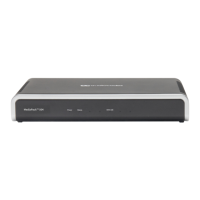SIP User's Manual 340 Document #: LTRT-65415
MediaPack Series
Parameter Description
NAT Parameters
Web/EMS: NAT Traversal
[DisableNAT]
Enables or disables the NAT mechanism.
[0] Enable
[1] Disable (default)
Note: The compare operation that is performed on the IP address is
enabled by default and is configured by the parameter
EnableIPAddrTranslation. The compare operation that is performed
on the UDP port is disabled by default and is configured by the
parameter EnableUDPPortTranslation.
Web: NAT IP Address
EMS: Static NAT IP Address
[StaticNatIP]
Global (public) IP address of the device to enable static NAT
between the device and the Internet.
Note: For this parameter to take effect, a device reset is required.
EMS: Binding Life Time
[NATBindingDefaultTimeout]
Defines the default NAT binding lifetime in seconds. STUN refreshes
the binding information after this time expires.
The valid range is 0 to 2,592,000. The default value is 30.
Note: For this parameter to take effect, a device reset is required.
[EnableIPAddrTranslation]
Enables IP address translation for RTP, RTCP, and T.38 packets.
[0] = Disable IP address translation.
[1] = Enable IP address translation (default).
[2] = Enable IP address translation for RTP Multiplexing
(ThroughPacket™).
[3] = Enable IP address translation for all protocols (RTP, RTCP,
T.38 and RTP Multiplexing).
When enabled, the device compares the source IP address of the
first incoming packet to the remote IP address stated in the opening
of the channel. If the two IP addresses don't match, the NAT
mechanism is activated. Consequently, the remote IP address of the
outgoing stream is replaced by the source IP address of the first
incoming packet.
Notes:
The NAT mechanism must be enabled for this parameter to take
effect (i.e., the parameter DisableNAT is set to 0).
For information on RTP Multiplexing, see RTP Multiplexing
(ThroughPacket) on page 310.
[EnableUDPPortTranslation]
[0] = Disable UDP port translation (default).
[1] = Enable UDP port translation.
When enabled, the device compares the source UDP port of the first
incoming packet to the remote UDP port stated in the opening of the
channel. If the two UDP ports don't match, the NAT mechanism is
activated. Consequently, the remote UDP port of the outgoing
stream is replaced by the source UDP port of the first incoming
packet.
Notes:
For this parameter to take effect, a device reset is required.
The NAT mechanism and the IP address translation must be
enabled for this parameter to take effect (i.e., set the parameter
DisableNAT to 0 and the parameter EnableIpAddrTranslation to
1).

